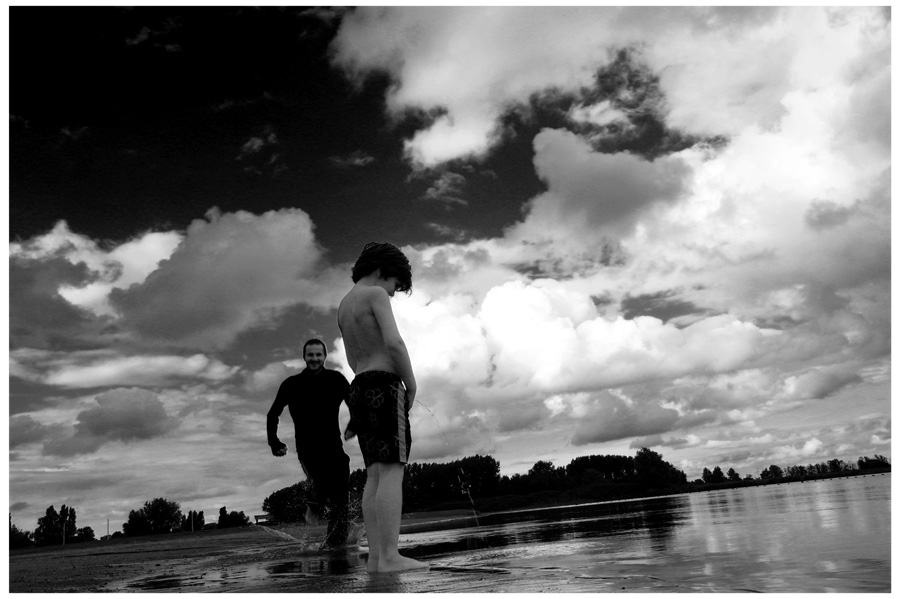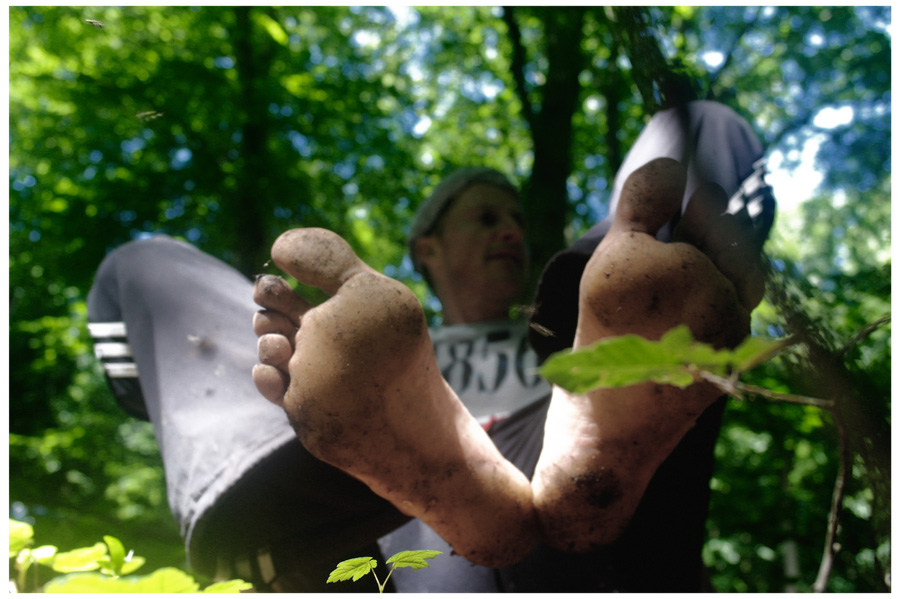In the name of the Father, and of the Zone, and of the Holy Spirit
- Details
- Hits: 6686

If there is one climax to the whole bunch of training-sessions reported on this website over the past few years, it will be that at the Core of all anabolic¹ action there is balance; unity of time (conquered from passivity) and space -- the Zone.
Balance. Raising the bar, pushing the limits, though not violating them (which leads to exhaustion). From the bottom up: act, grow, energize. Respect and enjoy rest and recovery - trough meditation, breathing, sleep and balanced food intake (don't vegetate by sinking deep into the comfort-zone into catabolic² behaviour on an overdose of entertainment and snacks³). Out of the Zone = out of balance.
"An artist who feels that he is driven into creating by an external deprivation and who is then again obstructed by a longing for life can rise above these conflicts to a renunciant view of life which recognizes that it is not only impossible but perilous to live out life to the full and can, willingly and affirmatively, accept limitations that appear in the form of moral conventions and artistic standards, not merely as such, but as protective measures against premature and complete exhaustion of the individual. [I]n the end his creativity [...] is freed from the need to justify one or other mode of life -- in other words, from the need for compensation." Otto Rank on page 417 of 'Art and Artist', first published in 1932 by Alfred A. Knopf, Inc.
_________
¹ I.e.: life-enhancing. See: 'Power vs Force' by David R. Hawkins
² I.e.: life-consuming. Ibid.
³ No news, TV and all that is not a bad idea at all. In fact it is a very good idea. It provides time and frees the mind of negative, fear based crap! Time to be given to training. Training in the Zone is done for the creation of unity, for the benefit of mankind. To merely consume the world trough the eyes of journalism and advertising is a waste of health mostly (an apology generator!) Trough training we develop looking at the world trough our own eyes. That is the real victory!
SAR_14(/14)_epilogue_secured
- Details
- Hits: 6678

Above: Footprint after completion 32K SAR14
"We are human. When our ego is not engaged, we turn passive." From: 'Forging an American Grand Strategy: Securing a Path Through a Complex Future. Selected Presentations from a Symposium at the National Defense University', chapter 7, 'GRAND STRATEGY AND HUMAN THINKING' by Evan M. H. Faber (link to full publication below)
"Abenteuer im Fleische und Geist, die deine Einfachheit steigerten, ließen dich im Geist überleben, was du im Fleische wohl kaum überleben sollst. Augenblicke kamen, wo dir aus Tod und Körperunzucht ahnungsvoll und regierungsweise ein Traum von Liebe er- wuchs. Wird auch aus diesem Weltfest des Todes, auch aus der schlimmen Fieberbrunst, die rings den regnerischen Abendhim- mel entzündet, einmal die Liebe steigen?" (Adventures of the flesh and in the spirit, while enhancing thy simplicity, granted thee to know in the spirit what in the flesh thou scarcely couldst have done. Moments there were, when out of death, and the rebellion of the flesh, there came to thee, as thou tookest stock of thyself, a dream of love. Out of this universal feast of death, out of this extremity of fever, kindling the rain-washed evening sky to a fiery glow, may it be that Love one day shall mount?)
From the epilogue of Thomas Mann's 'Der Zauberberg' ('The Magic Mountain'), published in 1924.
As posted along the way: SAR training is Kick-Ass-training, taking-over from previous 'management' (that led to overload and injury -- usually fear driven management) and re-establish control ("Get in, get it over with and get out!").
Change requires collaboration on all levels. Trough the creation of unity the runner leads/inspires/guides/informs/balances the transformation at hand. It requires growth from egotistical overload-behaviour towards- and transformation into- an Alert-balanced runner, who emphatically and sensibly controls his behaviour.
SAR training (bottom-line) is trail-training, focussed upon improvement of technique and effeciency. NO MATTER WHERE, NO MATTER WHAT: create optimum character-exposure and accelerated progression (run, built, jump, plunge, climb, fall, swim et cetera). Evolve alert and creatively and efficient and technically sound. Trough strategic use of available resources, including time, terrain, weather, technical-support (and injury treatment, food and rest).
And the ego better has some (controlled = trained!) kind of job in the accomplishment or it will (being bored) start to run things amuck, frustrate healthy control -- trough destructive, passive, negative, (self-)injurious and greedy behaviour. If the ego is a flip-side of the coin, money should keep on flowing, generating powerful results. Unmoving money stinks, but that is another story!
Our bottom-line-training gives us the tools to kick fat egos lazy ass. If it takes an injury to get us aware and start doing the work that needs to be done passionately -- we embrace that, doing so.
Welcome to SAR training!
What is optimum (character-)exposure?
Let's look at the technique of motion-picture storytelling: it refers to the full use of the recording-system's latitude (film) or dynamic range (digital) to visualise the story at hand, from beginning to the end.
Roger Deakins, ASC, BSC: "For film I will take a meter reading to judge my exposure. With digital capture I will do the same but have the added advantage of checking that exposure on a calibrated monitor. I would surely do the same if I were working [with the Blackmagic camera]. I take a meter reading of a face, when I am shooting a medium or close shot of an actor, and I judge my exposure from the way I want that face exposed within the balance of the shot.
In a situation where sunlight is hitting a surface and bouncing light into a character's face, I will expose for the face to be where I want it to be in the final image. If the sunlight is in shot and it 'blows out' I am not worried by that. There are plenty of situations where I have lit a shot with a direct artificial source and where the highlights of that light source are completely white. I have lit like that when shooting film and continue to do so with digital capture. The idea of 'clipping' does, I think, come from a time when some cameras could not deal with extreme contrast ratios. The latest digital cameras can deal with extreme contrast in a far more natural (film like) way. That is why I was shooting film until quite recently."
See more: http://www.rogerdeakins.com/forum2/viewtopic.php?f=6&t=2379
"Black is black and I am only concerned with exposing the 'bits' I want to be seen. The rest can go to black or to white when it feels right for them to go that way. For most of my time I struggle to reduce the light in a shadow, a task that becomes even more difficult [with a sensitive camera]"
See more: http://www.rogerdeakins.com/forum2/viewtopic.php?f=22&t=2938&sid=2381d5e2ee4c2edacb6c4e623c09e2ef
See also: http://278efy3ybwg25033p1al4ib176.wpengine.netdna-cdn.com/fma/files/2011/07/Hirschfeldonmeters.pdf
SSI publication: http://www.strategicstudiesinstitute.army.mil/pubs/display.cfm?pubID=1177
Great Black Magic camera test: http://bastiaanhoutkooper.com/blog
Black Magic experience in Amsterdam: https://bartvanbroekhoven.com/en-US/running/166-25fps-black-magic-shoot-amsterdam
Related SAR post: http://bartvanbroekhoven.com/en-US/running/75-sar-9-injury-control-interim-management
Training/today_footprint
- Details
- Hits: 6613

Above: I prefer to have my training around sunrise: it multiplies the already good effects, stimulating results during the day to come.
Todays training was 'equal-as-usual' in distance and terrain. It was in the afternoon though, it had more wind, more blue sky, more tide; different training altogether, best suited for the day!
And dedicated to an excerpt, published today, from a (new) book by Mark Divine. His writings, courses and trainings are an inspiration to many people:
"Drive provides a lifelong source of energy if focused on a passionate and worthy end. But be wary, because drive can have a dark side, too. When you’re driven solely by “me” reasons and you confuse determination with stubbornness, you can easily lose sight of the “we” in your life, leaving your coworkers, family, or other teams wondering what happened to that nice man or woman they used to know. The type of drive that powers elite operators is a “me plus we” drive. It means you’re driven to grow and learn new things in a way that benefits yourself and your team, and that is balanced with the needs of the organisation."
Mark Divine: Excerpt from 'The Way of the Seal'.
More here: http://wayofthesealbook.com/ and here http://www.sealfit.com/blog/marks-blog-excerpt-way-seal/
Enjoy!
SAR_sarsential™_toolbox_12/14
- Details
- Hits: 6615

Above: PGIA SAR training. Sarsential 12: Pit-Stop-Run™ (PSR) [ short, efficient training whilst on the road, supporting the blood flow and happiness of tendons, muscles and bladder ]
"We're in a car gotta get off the road, pronto!"
From 'Pulp Fiction, a Quentin Tarantino screenplay', last draft, scene 72, page 119. First published May 1993. In 1994 re-issued by Miramax books and Hyperion, New York.
"Hollywood has learned by trail and error to respect our 90-to-120-minute ultradian rhythm. If movies are too long, the audience will get restive and bored. The acute master of mood, Alfred Hitchcock, once wrote: "The length of a film should be directly related to the endurance of the human bladder." […] In baseball or football, we see the same ultradian need reflected in the seventh-inning stretch or halftime break, when fans get up and move around. […] That's what feeling good together means: being in synchrony with each other."
Ernest Lawrence Rossi on page 171 in 'The 20-Minute Break', first published in 1991 by Jeremy P. Tarcher, Inc., Los Angeles
"One of the movies of which I'm most proud is Peter Bogdanovich's 'Paper Moon'. We wanted to evoke the classic b&w Hollywood tradition pioneered by cinematographers like Arthur Miller, John Alton and Gregg Toland. 'Citizen Kane' was our biggest influence; I had seen it for the first time in Budapest in 1948 and it had made an indelible impression. Orson Welles and Peter were very close friends, and I got to meet my 'god' while we were preparing our film. I'd been testing b&w film with various filters but still hadn't found the right look. Orson said, "Use red filters, my boy." And I did, because although the filters reduced the film speed and meant I had to use big arc-lights to achieve the deep-focus look Peter wanted, the red filters created incredibly beautiful, dramatic skies and gave us exactly the expressionistic look we were after."
László Kovács about shooting Peter Bogdanovich's black-and-white movie 'Paper Moon', from interview 'The Storytelling of László Kovács, Cinematographer' by Jason Whyte, as quoted on http://www.cinematographers.nl/PaginasDoPh/kovacs.htm
See also: http://bartvanbroekhoven.com/en-US/running/134-sar-sarsential-toolbox-10-14
SAR_prologue
- Details
- Hits: 6562

Above: FP SAR 30K-BL-training. Sar training: Peal it off, adjust the parts and reassemble.


